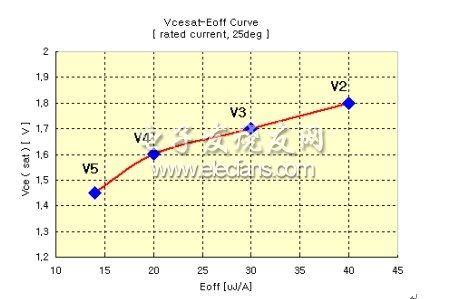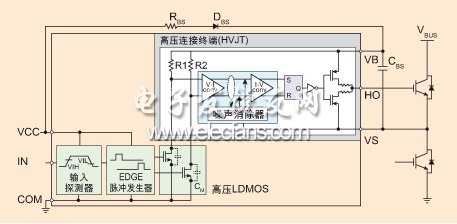power component
Due to advances in IGBT technology, the SPM series has been undergoing an upgrade since its first appearance in the industrial market. With the introduction of sub-micron design rules, not only is the chip size reduced, but the current density is greatly increased. The latest generation of IGBT chips achieves a better performance balance between turn-off loss and turn-on voltage drop while ensuring adequate SOA. Figure 1 shows an improvement in IGBT technology. Clearly, V5 IGBTs have excellent device performance, which increases power capacity in smaller packages.
Low-power operation often requires faster switching speeds, which results in increased recovery current and increased dv/dt, which can result in greater electromagnetic interference (EMI), high surge voltages, and motor leakage currents. During the development of the SPM series, EMI issues have been considered and the gate drive design has been optimized, sacrificing high switching speeds to control the switching speed of the integrated IGBT. It is because of the low on-voltage drop of the IGBT that it can maintain the overall power consumption while achieving low EMI characteristics. Figure 2 shows the typical dv/dt characteristics of SPM. At its rated current, the dv/dt is turned on and off below 5kV/μs.
In addition, for better ESD protection, a polysilicon back-to-back diode with sufficient clamping voltage is used between the gate and emitter. 2,350 & TImes; 2,350 square micron chip area can get the ESD level of HBM 2.5kV and MM 300V. With integrated protection diodes, all SPM products meet industry standard ESD levels.

Figure 1. Improvements in IGBTs in the SPM manufacturing process

Figure 2. Switch dv/dt characteristics (Vpn=300V, Vcc=15V, 25°, 20A rated current)
Driver IC
For cost-effective reasons, HVICs and LVICs are designed to have the minimum necessary functionality and are particularly well suited for inverter drives for consumer appliances. Design considerations include: reduced chip size with fine process technology; direct drive of an effective "high" interface by a 3V feed microcontroller; low power consumption; higher noise immunity; better resistance to temperature changes Sex and so on.
One feature of the HVIC is the built-in high-level offset function, as shown in Figure 3, which converts the PWM input from the microcontroller directly to the high-side power device. In addition, with an external charging reverse capacitor, the SPM can be driven with a single control supply.

A backup camera (also called reversing camera) is a special type of video camera that is produced specifically for the purpose of being attached to the rear of a vehicle to aid in backing up, and to alleviate the rear blind spot. Backup cameras are alternatively known as reversing cameras or rear view cameras. It is specifically designed to avoid a backup collision. Backup cameras are usually connected to the vehicle rearview monitors.
Vehicle Backup Camera,Mirror Backup Camera,Vehicle Mirror Backup Camera,Vehicle Heavy Duty Camera
Shenzhen Sunveytech Co.,LTD , https://www.sunveytech.com
